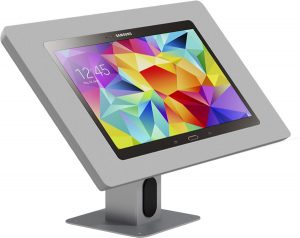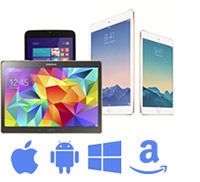STOP! Don't pick the cheapest tablet as the starting point!


As a manufacturer of custom tablet enclosures, we are often one of the first contacts for clients building their own custom, tablet-based displays or kiosks - but not always. Seeing this process repeatedly – we wanted to share one very important tidbit, which will help other kiosk & display builders:
“Stop! Don't pick the cheapest tablet as the starting point!”
Too often in these tablet kiosk / display signage projects, one of the natural tendencies is to start with choosing the least expensive tablet to “save on cost.” With the plethora of Android tablets available, there are now many options available in the sub-$100 price point.
While it may seem like a good idea to save some money, it’s actually a poor starting point, as we end up facing against multiple, often unnecessary problems:
1. Cheap tablets are often in limited supply
Did you know that most cheap, low cost tablets are usually produced in “short runs” – often using spare parts on clearance by OEMs? (Otherwise, why wouldn’t they produce more of these cheap tablets and make more profit?)
While that may not be a problem today – what if the tablet breaks, and we need a replacement? If a screen cracks or a port is broken, can we get parts for repair? While general failure rates are low for tablets, we definitely don’t want to be “stuck up the creek” when a prompt replacement is needed!
If this kiosk or display is meant for a long term setup, we would strongly encourage and recommend staying with name brands – such as Apple (for iOS), Samsung (for Android), or Dell/HP/Windows Surface (for Windows). If we search the secondary market, we can easily find plenty of iPad 2’s, or earlier gen Samsung tabs available for purchase – even years later after their initial release. Spending a bit more now may save a lot of headaches later on!
2. Cheap tablets are unlikely to have standard enclosures – Requiring custom builds (which negate any savings)
The next challenge after choosing the tablet is: how do we mount this tablet?
As one can easily see from our selection, we offer enclosures for the most popular Apple, Samsung, HP, and Windows tablets. While we’re capable of making custom enclosures for other tablets, note that there are minimums order quantities and lead times of several weeks involved. These prerequisites needed for custom tablet enclosures may end up negate any monetary savings provided by the cheaper tablet choice!
As mentioned in our other articles – spending a bit more up front on a popular tablet allows us to get an in-stock enclosure that is typically ready to ship, same-day: with no custom engineering charges, minimums, or unnecessary lead times!
3. Cheap tablets may have app performance / screen resolution issues
The last (and perhaps most important) question is: will the cheaper tablet do what we need it to do? Will the app run without problems? Can the app even be installed? Case in point – older iPads cannot be upgraded to the latest iOS versions… and the latest iOS versions are needed to run some of the latest apps… The same issues apply for Android tabs – see the problem?
In many projects where we’ve seen cheap Android tabs selected, it may have been a non issue if the app to be used will be developed from scratch (e.g. via sideloaded APKs, for example). However, what if the requirements change in the future? Is there a possibility of needing to replace the hardware (better processor? more storage / RAM?) so that future versions of the apps would perform best?
Furthermore – say if we are developing our own app.. Is the cheaper tablet’s screen a standard resolution, so that if we need to change or switch to another tablet / model (due to availability problems, performance requirements, etc.) – the user interface doesn’t need to be re-scaled & programming adjusted?
Simply put – be sure the tablet selected can handle the app to be used, or if we’re developing our own app, it’s best to pick a tablet with a standard / common screen resolution, so that in the event that we need to make a hardware change, there’s no or minimal user interface “re-work” that needs to be done.
Bottom line: Unless we’re doing a custom deployment of several dozen or hundreds of tablet kiosks / digital displays – it’s generally best to stay with a name brand, utilizing popular tablets. In small volumes where we’re only doing a handful of setups, this helps avoid potential supply issues if the tablet breaks, and also allows us to get an in-stock enclosure right away with no delays.
Don’t let the lure of small, short term savings create unnecessary problems in your next tablet kiosk / digital display project!





















